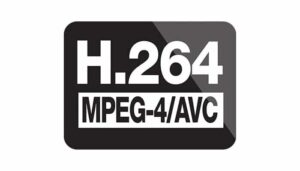The H.264 video codec is a video compression standard used to ensure high-quality videos across the digital video landscape. This compression technique minimizes bit rate while maximizing a video’s quality. Compared to previous compression standards, the H.264 codec offers superior efficiency and flexibility. As a result, this format is essential to learn for anyone in video production.
The key to H.264’s ability to maintain the same image quality while also compressing file size is a video codec created for practicality, scalability, and cost-efficiency. This technology helps control bandwidth used by streamers, YouTubers, video producers, and video podcasters alike!
This is all possible without giving up the visual excellence your audience expects. Helping you achieve crisp 4K video without bloated video files.

One of the biggest reasons to use compression on YouTube and other uploading sites is because you are required to. Long videos shot in HD video can end up with massive file sizes. Unless you are only uploading audio-based short clips, you will want to compress your content to save time, disk space, and resources.
However, the biggest thing to remember is that not all compression formats are created equally. H.264 is the most popular compression format for a good reason. It allows your file size to shrink substantially lower without harsh impacts on your video quality.
This advanced video encoding is a dream come true for the busy YouTuber with dozens of editing projects or the video podcaster looking to work as efficiently as possible.

Another reason to use compression when uploading online videos is to save yourself time and headaches. Larger than average file sizes are a frequent cause of uploading errors that can waste several hours’ worth of progress. An adequately compressed file will upload to your platform of choice much faster.
This gives you easier access, less room for error, and more time to focus on creation rather than post-production.
If you have a hectic uploading schedule, most high-efficiency video coding applications that follow the H.264 standard offer batch compression either as a free or paid feature. This is especially helpful when sending multiple videos back and forth between colleagues for commentary, feedback, or approval. Compressing your video files before uploading them can help save time and money.

H.264 (also known as advanced video coding or AVC) works by lowering bit rates without introducing more complexity to a file. As a result, H.264 achieves better image quality while using creative tricks to keep encoding flexible.
For example, this type of compression allows reference frames, which means using old encoded work as an aid. This is in addition to its variety of new features designed toward making this compression format as efficient as possible.
With the rise of using mobile devices to watch content, video content needs to be as compressed and easy to transmit as possible. With previous standards, the same content might require half a dozen different format exports to upload across the internet. This is why H.264 has become the industry standard. Not only does it make lives easier for both producers and consumers, but it lessens the amount of stress we put on our digital infrastructure.
The ease of using this format to decompress your videos in standard definition makes this format the best choice for general content creators. Despite this, H.264 encoding takes a lot of processing power, especially when using it during live streaming or video conferencing.
This is because, in order to reduce complexity within the file, the encoding process itself is complex and references multiple parts of your file as it works.
Many different H.264 codecs on the modern market uphold the industry standard. Which program you use for compression will depend on your needs, the type of content you’re making, and what kind of software you’re already using. Don’t be afraid to experiment with multiple different programs. Make sure you’re getting the results that advanced video encoding is capable of.
Keep in mind that the following software plug-ins are bundled into many programs you may already use! This means that there will be minimal extra downloading, researching, and learning involved with utilizing this encoding standard.

MainConcept codec is one of the most popular H.264 encoding software options available for good reason. With an easy-to-understand interface, seamless encoding, and accurate frame rendering, there are so many possibilities when using this platform. MainConcept also includes a variety of encoding templates for those just getting started. You can use these while you learn and grow as content producers.
MainConcept designed their basic H.264 encoder to provide flawless high definition without sacrificing file size. This handy software has something to offer at every stage of video compression from beginners to professionals. As it is one of the more popular compressor software options, there are plenty of video tutorials out there. These can help you gain a clearer understanding of all this platform can offer.

Apple’s proprietary Compressor is fully integrated with their Final Cut Pro software, making this the ultimate choice for content creators already in Apple’s system. With a modern user interface that helps cut the clutter out of complexity, this compressor works wonders regardless of how many different file sizes or apple codec you need to work with.
In addition, the simplicity of the user interface makes this compressor a perfect choice for newer creators, video podcasters, and video producers.
Designed to use all the processing power of a Mac to run the video encoding, using this software results in clean, crisp, and sometimes even better image quality. The ability to use all of your computer’s brainpower without putting it at risk is essential if you are working with large, complex video files. If you need to create high definition, high resolution, yet efficient video, the video encoding offered by Compressor is hard to beat.
x264 differs from most shareware encoders because of the wide variety of features it offers. This encoder supports all types of video formats by default, including Blu-ray discs and recording live streaming. It has everything one would expect based on the industry standards, from using B-frames as a reference for faster encoding to the ability to adjust the bit rate distribution.
x264 is a fantastic choice for beginners to learn due to it being free advanced video encoding software. If you are not sure that an external video compression software is necessary, it helps to be able to use one first before making a final decision.
Since x264 has a hefty features list despite being free, you will be able to learn and research proper video compression before spending any money.
If you are just starting in the world of creating and publishing online videos, any one of these compression tools will help you efficiently deliver your content in standard definition.
However, don’t be afraid to experiment! If the user interface of one program confuses you even after a few uses or you fail to find features that you need, there are always more programs to try.
Just because a compression plug-in or tool works for one genre does not mean that it will work for yours. Sometimes, even the standard settings offered by a compression program could be the reason why you’re unsatisfied with your results.
After you’ve understood the basic mechanics of your compression program, play around with the settings to see what type of results you can achieve.

Compression works in a variety of different ways to make larger file sizes smaller. In the past, and with some freeware software, this comes at the cost of a video’s quality. One of the most common signs of compression gone too far is grainy, pixelated footage. However, for some platforms, this is the only way you can upload your full video without paying for premium services.
Here is the article which will help to understand How to remove background noise from video without any headache.
H.264 compression techniques have changed the game for distributing video content. However, even with the most popular video-sharing platforms, such as Facebook, and TikTok, having a high-quality video doesn’t mean much if it takes ages to upload or download.

One of the keys to your online video reaching a broad audience is finding the right balance between quality and file efficiency. With the technology available these days, you often won’t notice a difference between your original video’s quality and your new compressed file, ready to publish on any online video platform.
However, it’s essential that you avoid compressing the same file more than one time. If you find your content is still too large to upload, you may need to edit content for time.
If you decide to use a standalone compression application, make sure it is the last step in your process. Editing video content that has already been compressed puts you at risk of losing quality, needing to compress it again, and losing some of the clarity in your video. Therefore, compression should always be your final step before uploading a video anywhere online.
H.265 or HVEC (High-Efficiency Video Coding) is an improved follow-up to H.264. H.265 compresses video more efficiently than H.264, leading to smaller file sizes that require less bandwidth to stream and less space for storage while offering similar image quality at a lower bit rate.
However, while there are many positives to using H.265, it also requires more processing power to encode and decode. Due to this, encoding a video in H.265 may take up to twice the amount of time as H.264 video encoding. For now, H.264 may be the king of video compression, yet as hardware improves, we may see H.265 become the new standard.
Using a video compression standard as comprehensive as the H.264 video codec allows you to focus on the quality of your content without needing to compromise. Because you have the ability to add this compression technology as a plug-in to many popular non-linear editors, compression can be easily worked into your workflow.
If you decide to use a standalone program for H.264 high-quality compression, you can see amazing results without sacrificing quality or file size.
Which method of H.264 advanced video coding works best will depend on how you create, what type of content you make, and where you plan to upload your finished video. For many beginning creators getting through post-production as quickly as possible is critical; this is where compression plug-ins shine.
Inevitably a situation will come up, however, that makes a creator curious about the power of a standalone compression app. When this happens to you, refer back to this article to help you make the right choice.
Overall, remember that the world of uploading videos is fast changing. A little bit of research goes a long way. If you find that your compression isn’t making a huge difference in your file sizes, experiment! Never be afraid to try something new in the pursuit of higher quality, more efficient video.